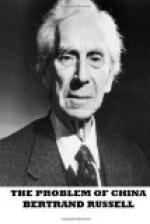CHAPTER V
JAPAN BEFORE THE RESTORATION
For modern China, the most important foreign nation is Japan. In order to understand the part played by Japan, it is necessary to know something of that country, to which we must now turn our attention.
In reading the history of Japan, one of the most amazing things is the persistence of the same forces and the same beliefs throughout the centuries. Japanese history practically begins with a “Restoration” by no means unlike that of 1867-8. Buddhism was introduced into Japan from Korea in 552 A.D.[40] At the same time and from the same source Chinese civilization became much better known in Japan than it had been through the occasional intercourse of former centuries. Both novelties won favour. Two Japanese students (followed later by many others) went to China in 608 A.D., to master the civilization of that country. The Japanese are an experimental nation, and before adopting Buddhism nationally they ordered one or two prominent courtiers to adopt it, with a view to seeing whether they prospered more or less than the adherents of the traditional Shinto religion.[41] After some vicissitudes, the experiment was held to have favoured the foreign religion, which, as a Court religion, acquired more prestige than Shinto, although the latter was never ousted, and remained the chief religion of the peasantry until the thirteenth century. It is remarkable to find that, as late as the sixteenth century, Hideyoshi, who was of peasant origin, had a much higher opinion of “the way of the gods” (which is what “Shinto” means) than of Buddhism.[42] Probably the revival of Shinto in modern times was facilitated by a continuing belief in that religion on the part of the less noisy sections of the population. But so far as the people mentioned in history are concerned, Buddhism plays a very much greater part than Shinto.
The object of the Restoration in 1867-8 was, at any rate in part, to restore the constitution of 645 A.D. The object of the constitution of 645 A.D. was to restore the form of government that had prevailed in the good old days. What the object was of those who established the government of the good old days, I do not profess to know. However that may be, the country before 645 A.D. was given over to feudalism and internal strife, while the power of the Mikado had sunk to a very low ebb. The Mikado had had the civil power, but had allowed great feudatories to acquire military control, so that the civil government fell into contempt. Contact with the superior civilization of China made intelligent people think that the Chinese constitution deserved imitation, along with the Chinese morals and religion. The Chinese Emperor was the Son of Heaven, so the Mikado came to be descended from the Sun Goddess. The Chinese Emperor, whenever he happened to be a vigorous man, was genuinely supreme, so the Mikado must be made so.




